Japanese cotton cheesecake is a light and fluffy treat for the discerning cheesecake connoisseur. Often described as a combination of the more classic creamy cheesecake and a soufflé. This wonderfully airy treat is one you don’t want to miss!
Come closer, bestie. I’ve got a secret to tell you.
Closer.
A little closer.
…You are so going to love this recipe!
This Japanese Cotton Cheesecake recipe has been one of my most requested recipes ever since I posted my fluffy Japanese pancakes recipe. And I’ll be honest, I’ve really taken my time with it. I’m always super thorough when testing my recipes (it’s a long, delicious process). But when it came to testing and perfecting this Japanese cheesecake recipe, I really took my time. A whole year.
And sure, you can argue part of that was because I’d eat my cake without waiting to take photos every time I made it. Or because I wanted to keep this recipe to myself (like some kind of ancient Japanese souffle-treasure). Or because I made no less than six of my Japanese-speaking friends check over the katakana spellings in the section below…multiple times, because the way I was spelling “cheesecake” (in Japanese) just looked off. But the truth is, you’ll never know.
Seriously though, does the spelling look off to you? Don’t you think it would look right with an extra ケ instead of the キ? Just me? Okay.
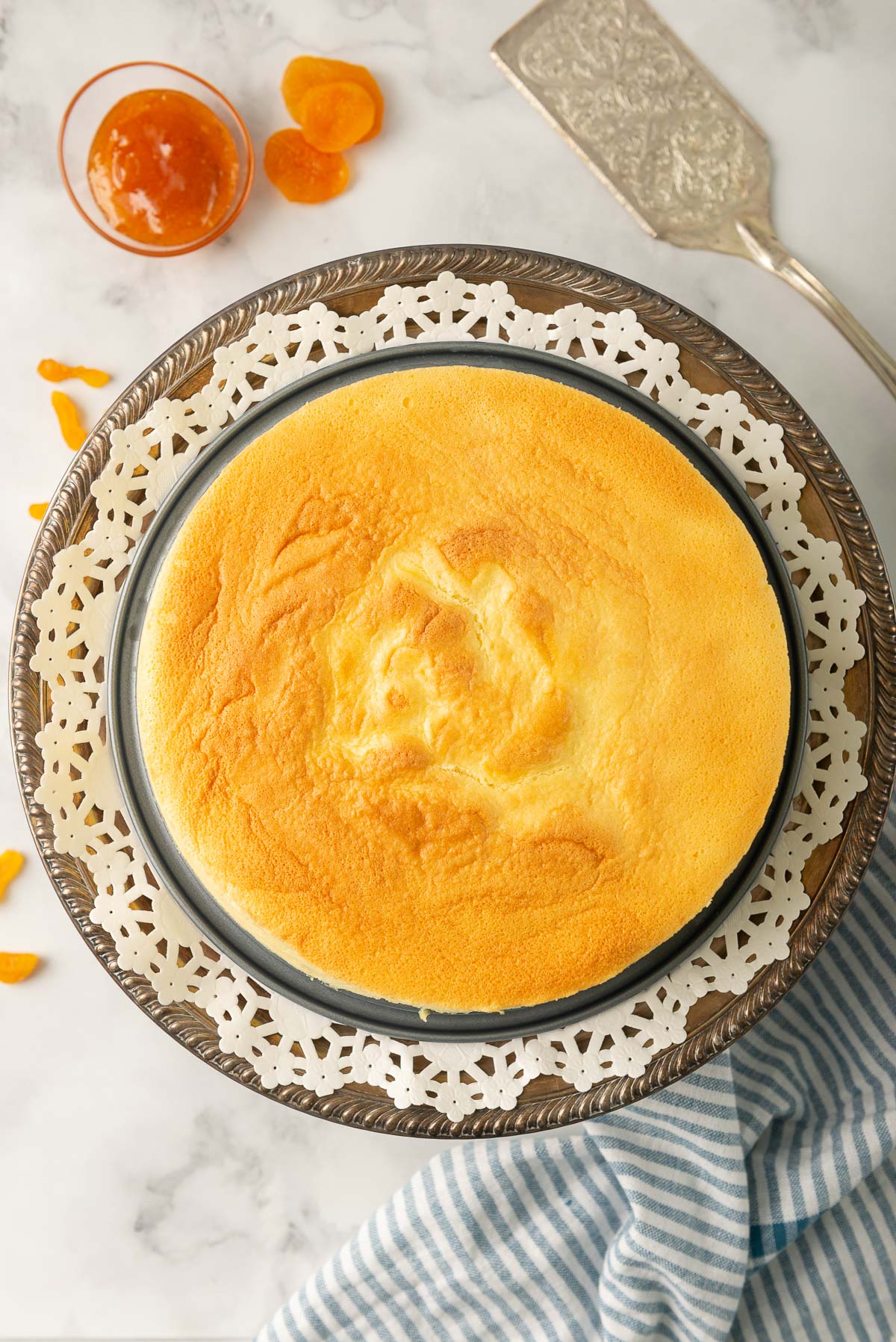
Jump to:
What is Japanese Cotton Cheesecake
Japanese cotton cheesecake is a light and fluffy treat for the discerning cheesecake connoisseur. Often described as a combination of the more classic creamy cheesecake and a soufflé.
In fact, if you’re in Japan, you’ll find that Japanese Cheesecake is actually referred to as soufflé cheesecake (スフレチーズケーキ). If you just ask for cheesecake, you might end up getting a slice of ベイクドチーズケーキ…that is, ‘baked cheesecake’ – which is essentially the same as the cheesecake we have here in North America.
This wonderfully airy treat is one you don’t want to miss.
How is Japanese cheesecake different from American cheesecake
Japanese cheesecake differs from American cheesecake (aka. baked cheesecake) in two main ways – preparation and flavour/texture. While the standard baked cheesecake batter is whipped together and baked, a Japanese cheesecake incorporates a meringue (this requires separating and preparing the egg whites separately) before baking in a bain Marie.
The result is an airy cheesecake with a cotton-soft texture, and a more subtle flavour, with a lot of jiggle. It’s usually less sweet than a baked cheesecake which usually aims for creaminess, and not much jiggle at all!
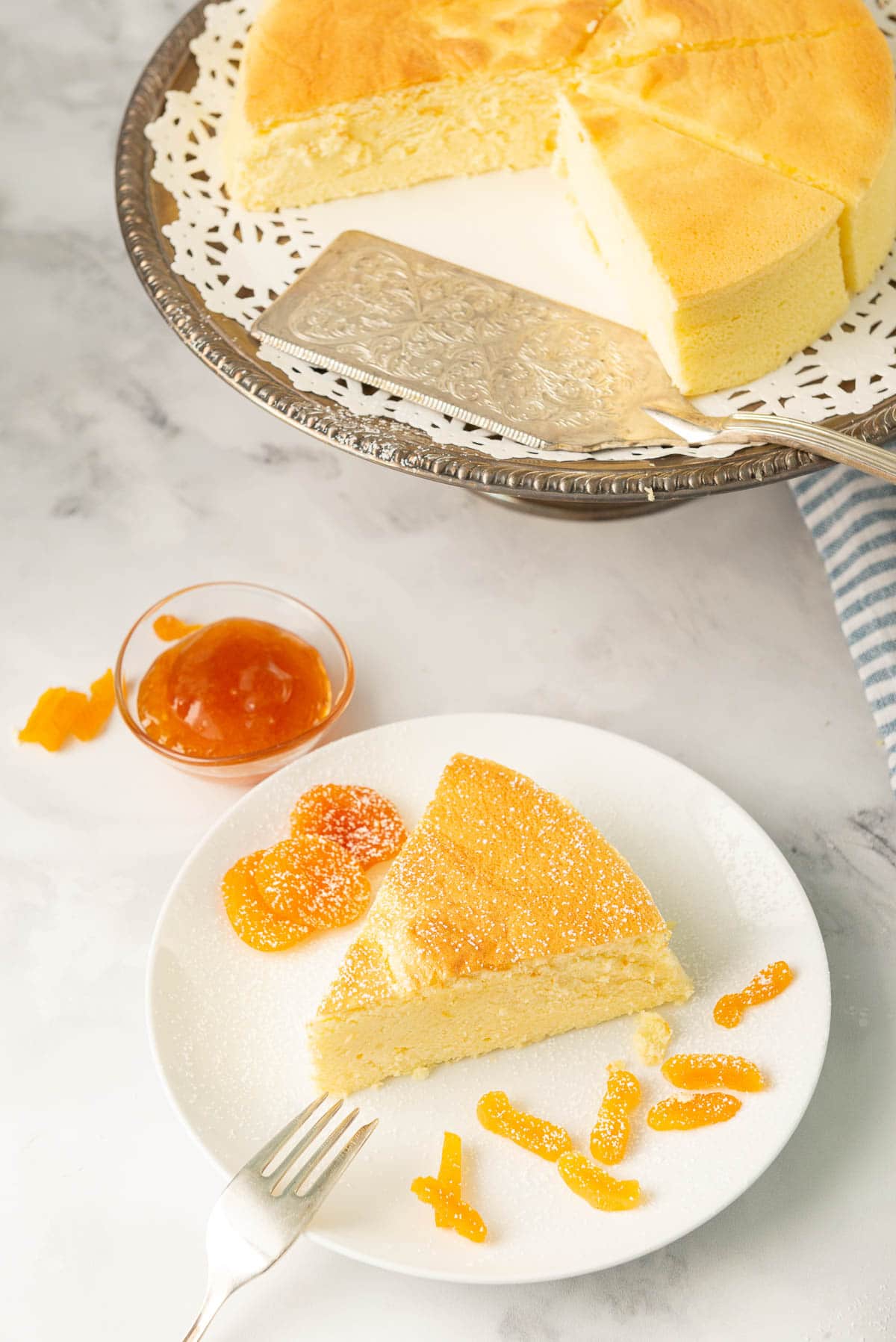
What makes Japanese cheesecake so jiggly
Cotton cheesecake is prepared by mixing an egg white meringue into the cheesecake batter, and baked using a bain Marie (which is fancy French-speak for a hot water bath – “Marie’s bath”) – essentially, a bowl containing hot water in which another bowl is placed.
Adding the meringue into the cheesecake mixture brings structure and room for air into the cheesecake. The baking process, tempered using the bain Marie, allows for the cheesecake to delicately rise and set. The result is a souffle-like texture, and the ability to jiggle!
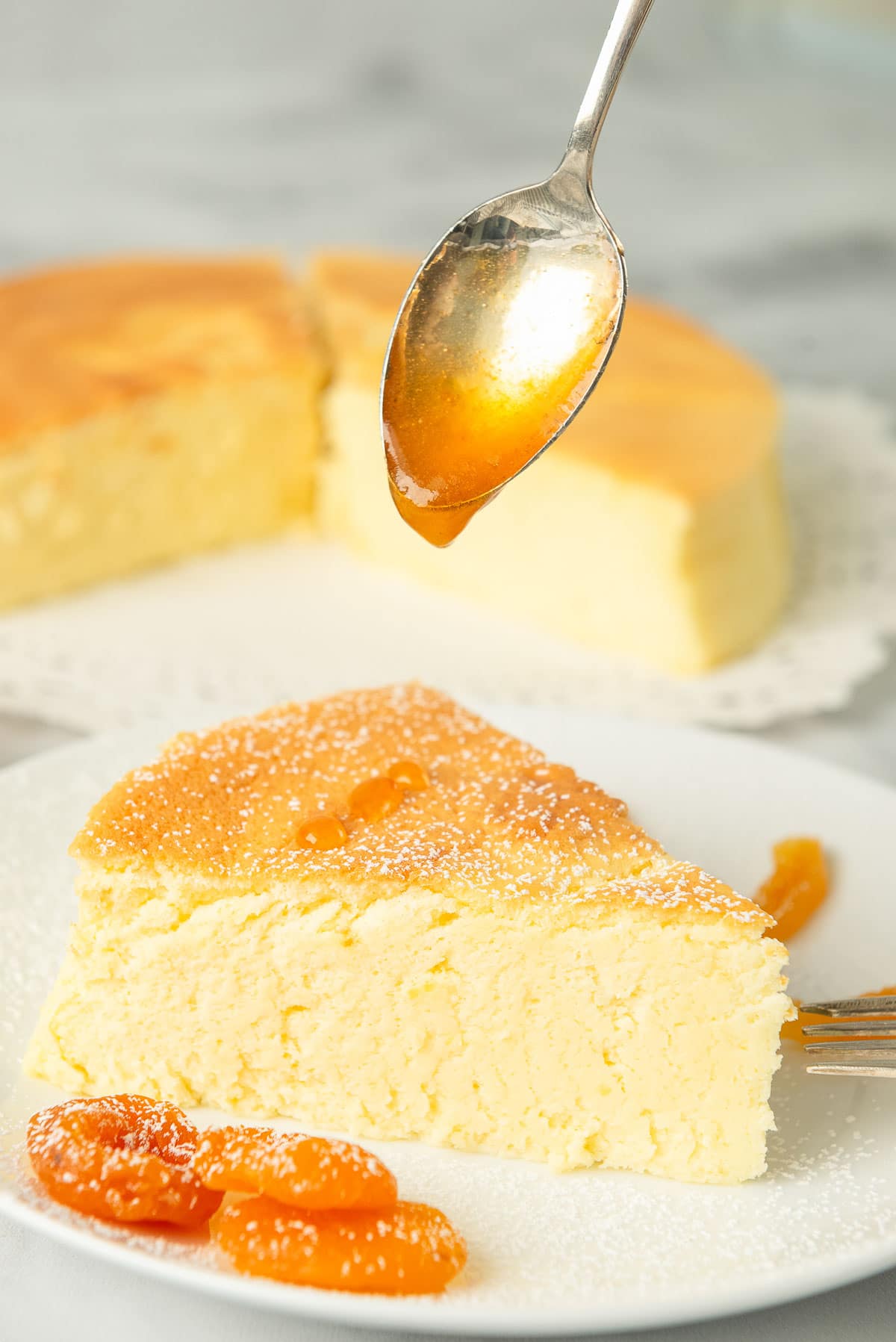
Tips to make the best Japanese cheesecake
The perfect Japanese cheesecake can be a fickle mistress. There are three areas that tend to cause the most problems:
Getting the perfect meringue consistency
It’s important to whip your meringues to a “medium” peak – so don’t let that stand mixer go crazy on your egg whites, bestie. I know, I know…usually, it’s a soft peak, or a hard peak…but here I am telling you to find a medium peak. What you want is something that won’t flop about everywhere, but also something that doesn’t stand to attention like it’s auditioning to join a pastry military.
Quick tips for meringue mastery
- Refrigerate the egg whites in a large clean mixing bowl until it’s time to use them.
- Make sure your beaters and mixing bowl are clean and dry. A speck of oil or egg yolk on either one can negatively impact the volume of the meringue that will be made.
- Avoid using plastic bowls as they often hold oily residue more than other materials (yes, even after they’ve been washed!). That said, if the only thing available is a plastic bowl, you can still find success here.
How to prevents cracks
Cheesecake and cracks have a long contentious relationship. Personally, I don’t think there’s anything wrong with a cracked cheesecake. However, I understand that for many, this is an aesthetic element that’s crucial to a successful cheesecake.
The key is to bake at a low temperature for a long time, and then reduce the temperature to prevent the cheesecake from drying out too quickly. If you follow the recipe instructions, you should be fine on this front.
Using a bain Marie (water bath) is quite important to this recipe in general. But if you want a crack-free cotton cheesecake, it’s a mandatory measure. The steam from the bain Marie helps to cook the cheesecake while maintaining moisture, and thus preventing cracks (especially since the bake time isn’t exactly short).
How to stop your cheesecake from deflating
Once you’re done baking your cheesecake, this recipe requires that you turn off the oven, leave the oven door open, and allow the cake to cool inside the oven for an additional 15-20 minutes (if you have time, you can actually leave it there longer till to allow it to cool even more). It’s important to note that your cheesecake will deflate.
However, what we’re trying to avoid is the type of deflation that occurs when you introduce a rush of cool air suddenly to the hot cheesecake, whereby the inflated cake can almost collapse on itself – it’s a sad sight. Take my word for it, bestie. Don’t ask me how I know.
What if my cheesecake cracks
Sometimes you can do everything right and still end up with a cracked cheesecake. This can be the result of any number of unforeseeable things (such as the humidity in the air that day, or something specific to the oven being used).
It’s important to note that the flavour of a cracked cheesecake is exactly the same as a crack-less cheesecake.
Luckily, we have a solution built into this recipe that bakers have been secretly using for years. All you need to do to cover the cracks is apply a little extra apricot glaze. It works like magic.
Seriously, ever bought a cake and wondered why there seems to be a little extra frosting? It’s not because the baker was in an extra good mood that day. Whispers: It’s because the cake cracked.
(I hope you appreciate me revealing these secrets. The pastry Illuminati will likely try to silence me after this. If you don’t see any more posts from me, let the world know of my sacrifice. Tell them the truth about the pastry Illumina-…
Hello. I am Riz. Everything is fine. Please carry on.
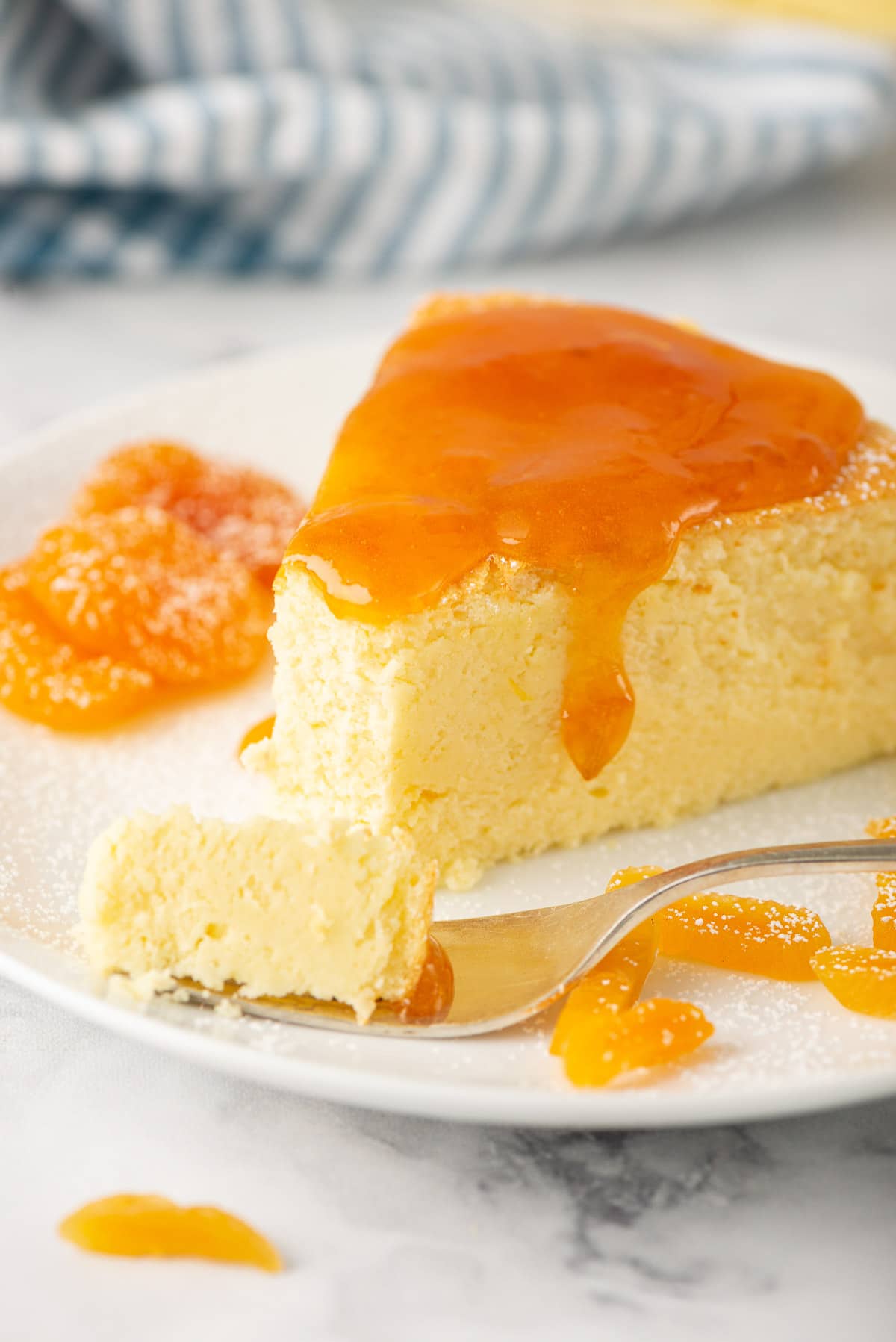
How to prepare the apricot jam glaze
The traditional topping for a cotton cheesecake is an apricot jam glaze. It’s by no means a compulsory part of the recipe. In fact, if you’re looking for a Japanese cheesecake recipe that’s less on the sweet side, I’d suggest you omit it.
You have two options here. The first is just to spread apricot jam on top of your cheesecake. I personally don’t do this as the viscous jam can sometimes tear the delicate cheesecake. Instead, I mix two tablespoons of jam with 2 teaspoons of hot water, and then carefully spread on top. (If you want more glaze, just double or triple the amounts)
How to decorate your cotton cheesecake
If you’d prefer not to use the more-traditional apricot glaze, another popular option is to sprinkle icing sugar over the top of the cheesecake. I’ve actually seen some beautiful souffle cheesecakes that have patterns made by icing sugar being dusted on top of the cheesecake (you can use a stencil or a doily to create the patterns).
Storage instructions
Storing a Japanese cotton cheesecake is pretty much the same as any other type of cheesecake – it’ll be fine in the fridge for 2-3 days, ideally in an airtight container to prevent it from drying up. But be honest without yourself, bestie. It’s not going to get to the point where you need to store it.
Can you freeze Japanese cotton cheesecake
I wouldn’t recommend it. The airy texture of the cheesecake doesn’t thaw well.
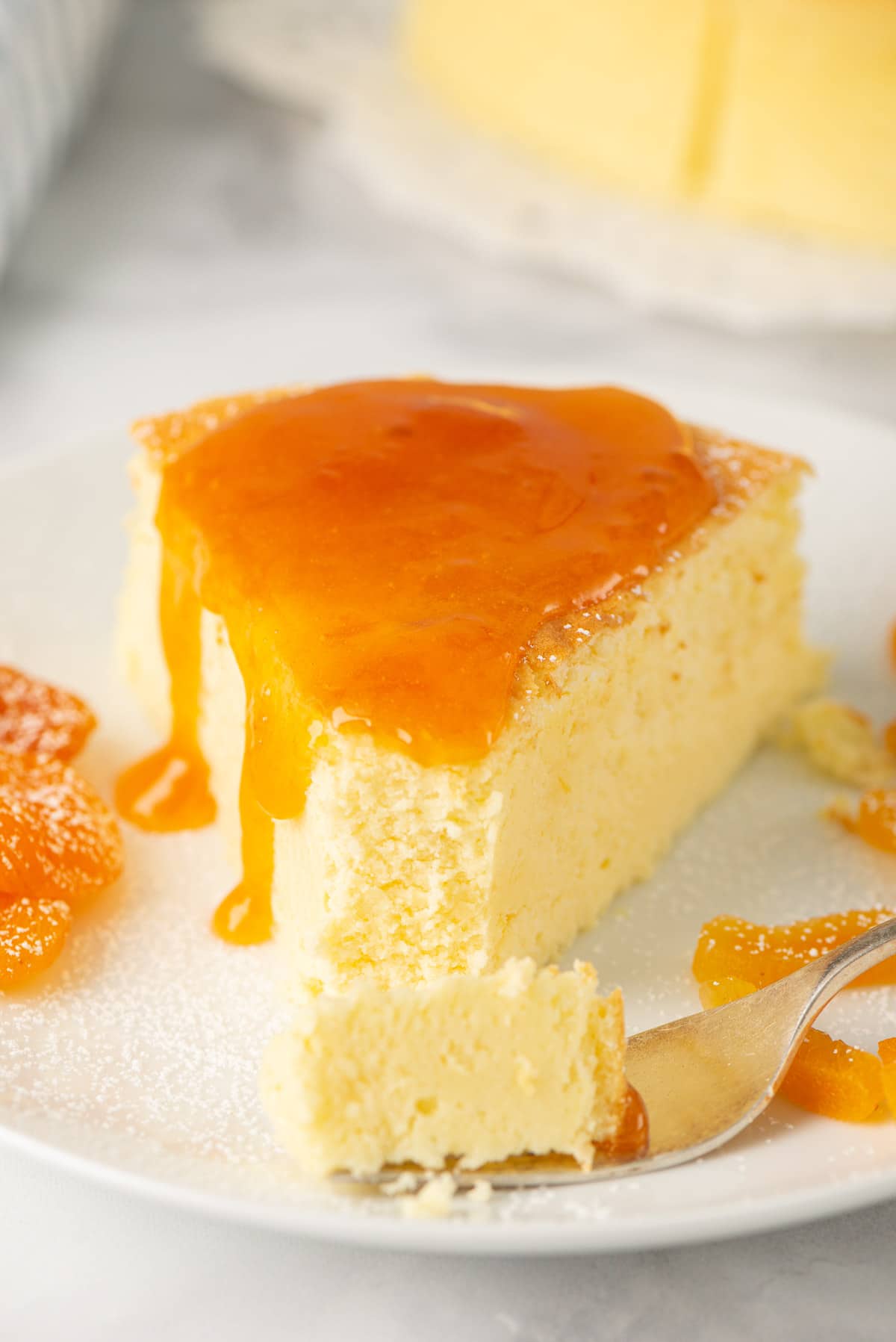
More cheesecake recipes
- Burnt Basque Cheesecake
- Raspberry Cheesecake-stuffed Pound Cake
- Chocolate Covered Raspberry Cheesecake
- Blueberry Swirl Cheesecake
- Strawberry Cheesecake Pancakes
- No-Bake Oreo Cheesecake Bars
Helpful tools
The link below is an affiliate link. This means that if you choose to purchase using it, I will receive a small commission (at no additional cost to you). These small commissions help keep Chocolates & Chai going. Thank you.
You’d think this recipe would require a lot of specialist equipment. But as long as you have a springform pan and an electric mixer, you’re likely going to have everything you need already.
And if you’d like to help support Chocolates & Chai, I’d appreciate it if you buy me a coffee – caffeine helps me write recipe posts.
So. Have you ever tried Japanese Cotton Cheesecake? Did you enjoy it? Or do you prefer a regular baked cheesecake? Tell me all about it in the comments below.
Bestie. Help me! The pastry illuminati. They’re after me! Follow me on Instagram, Facebook, Pinterest, YouTube, and Twitter. You can also sign up to my mailing list. It’s the best way to find me. Also, the truth will set you free.
Let’s Reminisce
One Year Ago: Lemon Blueberry Scones
Two Years Ago: How to make Dulce de Leche with Condensed Milk
Three Years Ago: Kunafah (Middle Eastern Cheese Pastry)
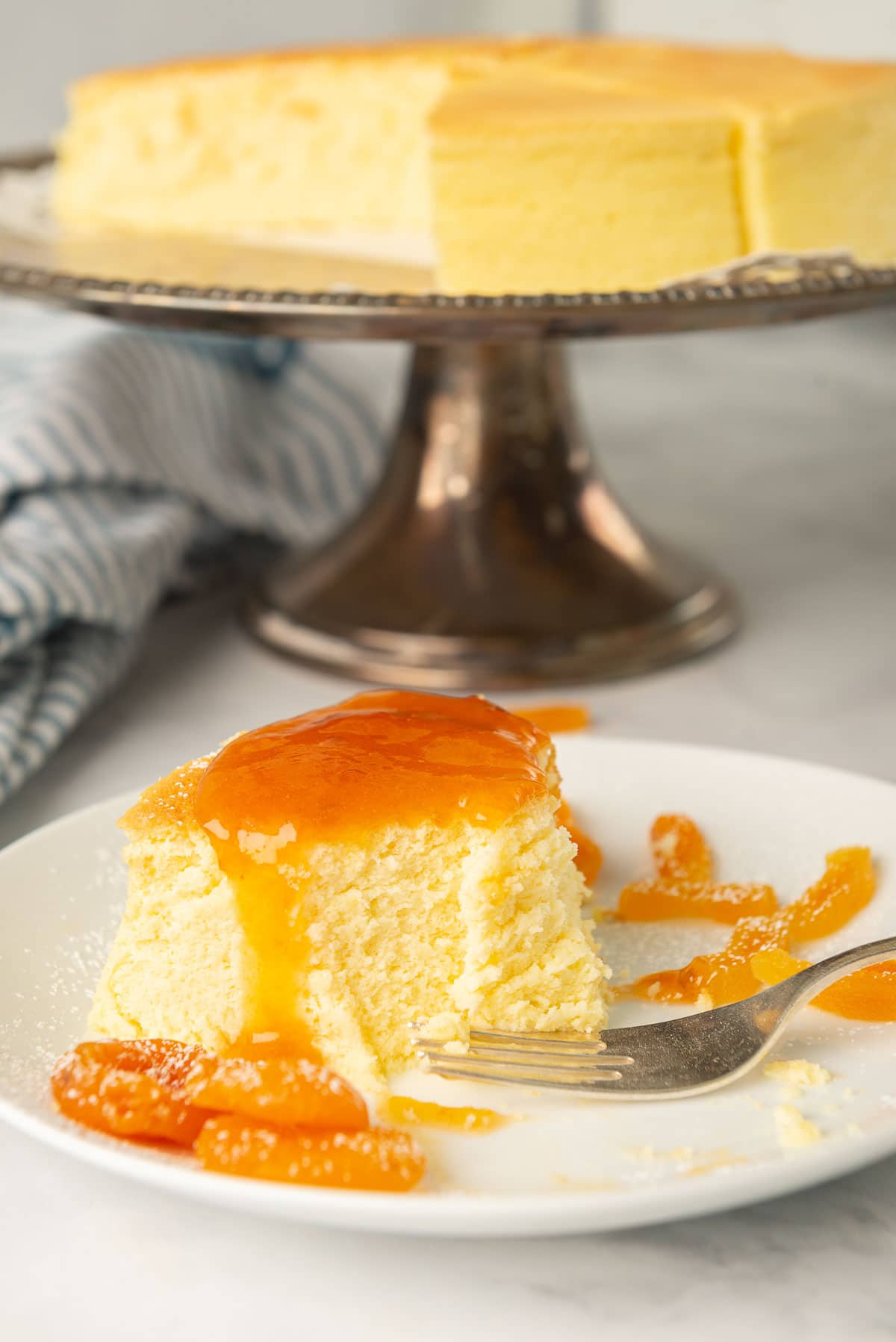
📖 Recipe
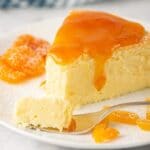
Japanese Cotton Cheesecake
- Total Time: 1 hour 50 minutes
- Yield: 1 Japanese cotton cheesecake 1x
- Diet: Vegetarian
Description
Japanese cotton cheesecake is a light and fluffy treat for the discerning cheesecake connoisseur. Often described as a combination of the more classic creamy cheesecake and a soufflé. This airy treat is one you don’t want to miss!
Ingredients
- 1 tbsp unsalted butter, for greasing
- 6 egg yolks, room temperature
- 6 egg whites, refrigerated
- 300g cream cheese (10.6 oz), room temperature
- ¼ cup unsalted butter, softened
- 1 cup + 2 tablespoon whipping cream, room temperature
- 5 tbsp + 8 ½ tablespoon white sugar (keep them separate)
- 9 tbsp cake flour, sifted
- ½ lemon, zest
- 2 tbsp lemon juice
Instructions
Prepare the pan
- Generously grease a 9-inch springform pan with butter. Wrap the bottom and up the sides of the pan with a sheet of tin foil, this will prevent water leaking into the pan while baking. Set aside.
- Preheat the oven to 320 degrees F.
Prepare the batter
- In a large bowl, whisk together the cream cheese, butter, whipping cream, and 5 tablespoons sugar.
- Whisk in the egg yolks, one yolk at a time, ensuring that each egg yolk is fully incorporated into the batter before adding the next one.
- Mix the cake flour into the batter.
- Pass the mixed batter through a fine mesh strainer into a large bowl. Mix in the lemon zest and lemon juice. Set aside.
- Set up a Bain-Marie in the oven (make sure it’s large enough for your cake pan!). Make sure to close the oven door afterwards.
- Using an electric mixer, whisk the egg whites on medium speed until they become opaque, foamy and bubbly, about 2 minutes. Continue mixing, and add the 8 ½ tablespoons of sugar – it’s best to do this in 3-4 instalments.
- Increase the mixer speed to high, beat the egg whites until ‘medium’ peaks form (that is, not so soft that they flip flop everywhere, but not completely stiff. If you turn the beaten whites on a whisk, you want it to resist and hold its shape for a couple of seconds before flopping over).
- Whisk in a third of the beaten egg whites into the cream cheese mixture until incorporated. Delicately fold another third into the mixture. And then finally, gently fold in the remaining egg whites.
- Pour the mixture into the prepared baking pan. Tap the bottom of the cake pan a few times on your kitchen counter to release air pockets hiding in the batter.
Time to bake a Japanese cheesecake
- Place the cake pan into prepared Bain Marie in the oven. Bake for 75 minutes. Reduce the oven temperature to 300 degrees F, and bake for another 10 minutes, or until the top is golden brown and skewer inserted comes out clean. Don’t remove your cheesecake from the oven just yet.
Let it cool
- Turn off the oven and leave the oven door ajar for 15-20 minutes with the cake inside. (Taking the cotton cheesecake out of the oven immediately could cause the cake to shrink or collapse.) Allow the cake to slowly deflate to about half the height it was when you turned the oven off – about 2 inches tall. Remove the baking pan from the oven. Remove foil from the pan, and open the spring-lock so that the cake can be carefully removed.
- Optional Brush the apricot glaze (recipe instructions are in the post) over the top of the cheesecake. If you’d prefer to not brush the cake with the traditional apricot mixture, that’s totally fine. You can leave it as is. Or decorate it with dusted icing sugar (after it has cooled).
- Let cool to room temperature. Chill the cake for at least 2 hours before serving. Celebrate by eating.
Notes
- This recipe can be a bit of a handful, bestie. I’d recommend preparing and measuring out all your ingredients in advance, as well as getting familiar with what a bain Marie is (hint: I’ve explained it in the post).
- You may notice that I’ve used weight for the cream cheese amount in the ingredients section. There’s a reason for this. We need the accuracy, and cup measurements just won’t work well for you here. If you don’t have a kitchen scale, just look at the cream cheese packaging as the weight is usually noted.
- Refrigerate the egg whites in a large clean mixing bowl until it’s time to use them. You should also check out the tips section above to learn more about preparing the meringue correctly.
- All-purpose flour and cake flour are not the same thing. Cake flour is more delicate, and if you use all-purpose flour instead of cake flour, the texture will be dense and tough. There are a couple of methods to effectively turn all-purpose flour into cake flour, but none that I feel confident recommending at this point. (If you’re feeling brave, google away bestie!) Cake flour IS however the same as pastry flour, so no worries there!
- Prep Time: 25 minutes
- Cook Time: 1 hour 25 minutes
- Category: Dessert
- Method: Baking
- Cuisine: Japanese

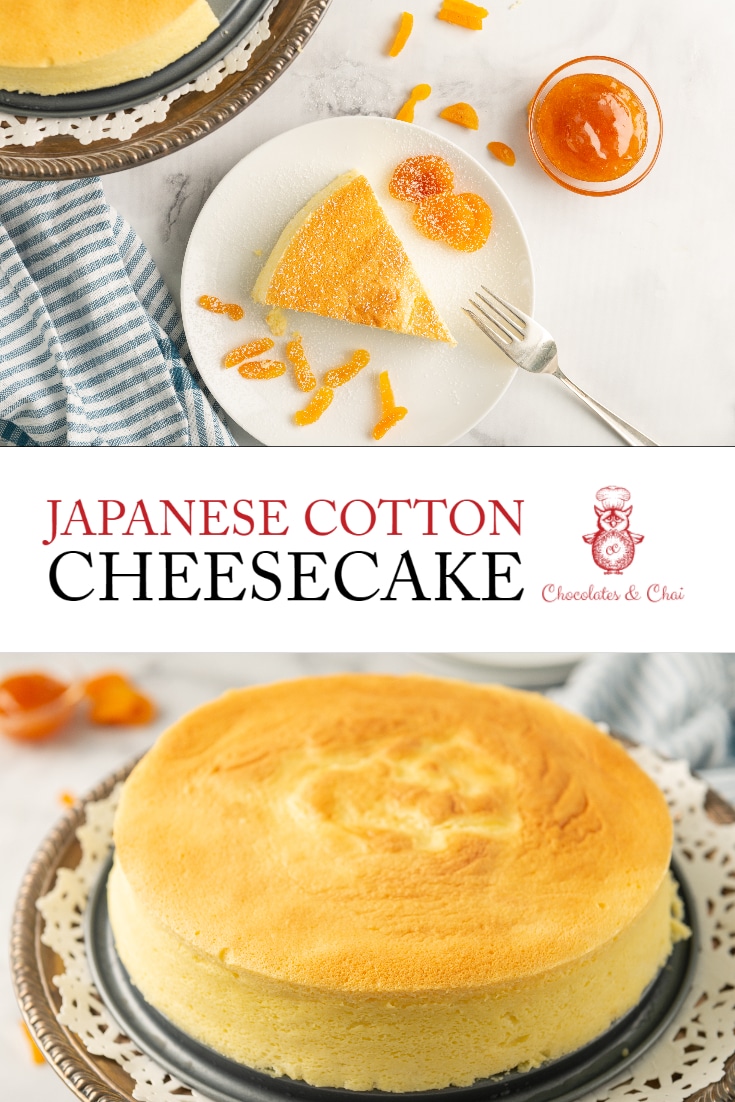

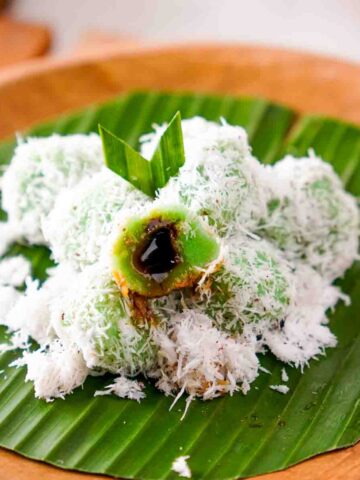
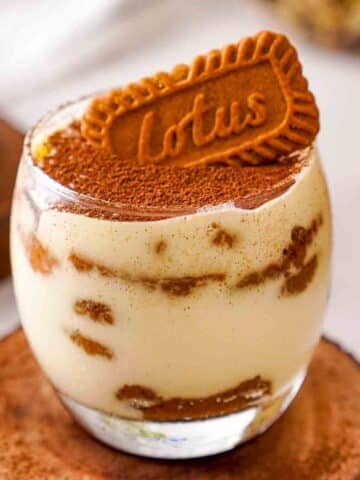
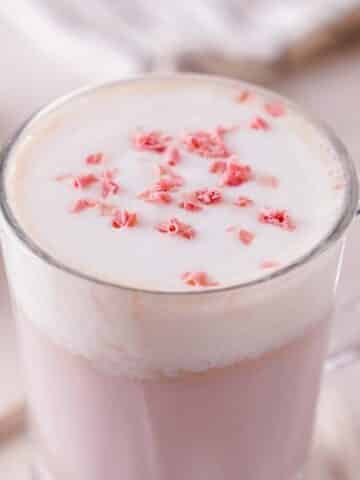
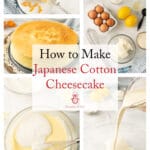
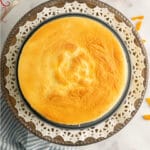
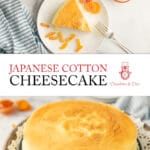
Sarah
Wonderful, Riz! My husband still talks about your lemon and raspberry cake recipe that I made for him over a year ago! Now he’ll start talking about this one!!! haha
Riz
Aww, thank you Sarah!! That’s so very sweet! I hope you enjoy this cake just as much as the last one (if not more!).
veenaazmanov
Soft, moist and cheesy. Super delicious and best cake recipe. I just cant wait to try this out.
Riz
Thank you very much, Veena. I hope you enjoy it!
Aleta
Now this is a cheesecake that is perfect for me. I am crazy about cheesecake and meringue, so it’s a match made it heaven! I’m going to make it for my mothers birthday!
Riz
Oh!!! How lovely! Happy Birthday to your mum!! And I hope both of you love this recipe 🙂
Adene
i’ve never made a cheesecake like this before so i was scared. especially about the sieve part. but it worked perfectly.! thank you!!!
Riz
Ahh!! So happy to hear it, Adene! And WELL DONE!!! I’m so happy you gave this a shot, and even more so since it turned out well!
Jess
I made this for the first time and unfortunately it didn’t turn out, but that was my error. I’ll try again and hopefully will have better luck. My one recommendation is adding more info about the Bain Marie. I’ve never used a water bath before so I had to go googling to figure out how high the water should be, how much bigger the second pan needed to be, and if the water I added should be hot or cold. That kind of info in the beginning would be really helpful. Thanks for the recipe!
Riz
Hi Jess, thanks for the feedback! I’ve adding “bain marie basics” to my list of posts to write, and as soon as it’s ready, I’ll make sure to create a link on this post to it. I can totally see how it might be a little daunting to someone that’s not used one before. Hoping you’ve had more luck your second time around!
Just in case you’re still wondering:
-The height of the water should be about halfway up the cheesecake dish.
-For the second pan (the bain marie itself) – you want it to ideally be big enough to fit your cheesecake pan into, and deep enough that you can fill water into that will go halfway up the cheesecake pan.
-Ideally, the water should be boiled. But just using hot water is usually fine (I usually just use hot tap water).
Riz